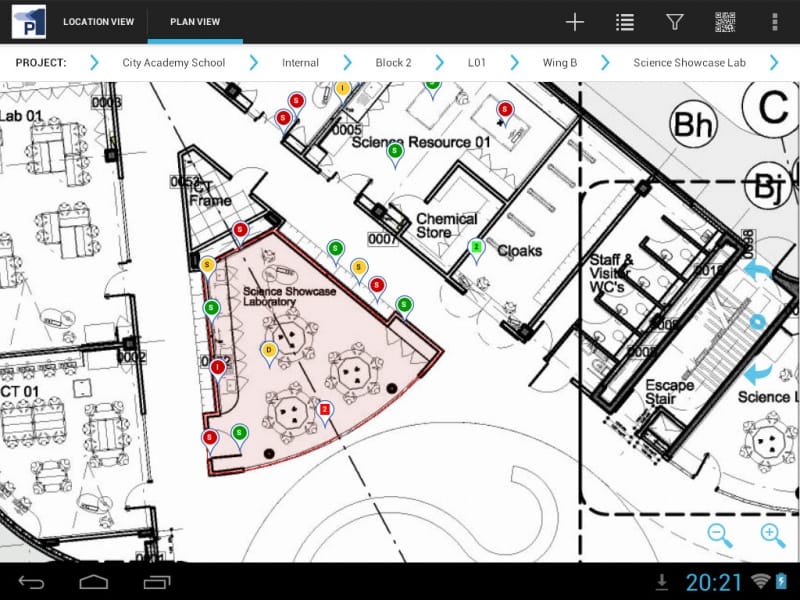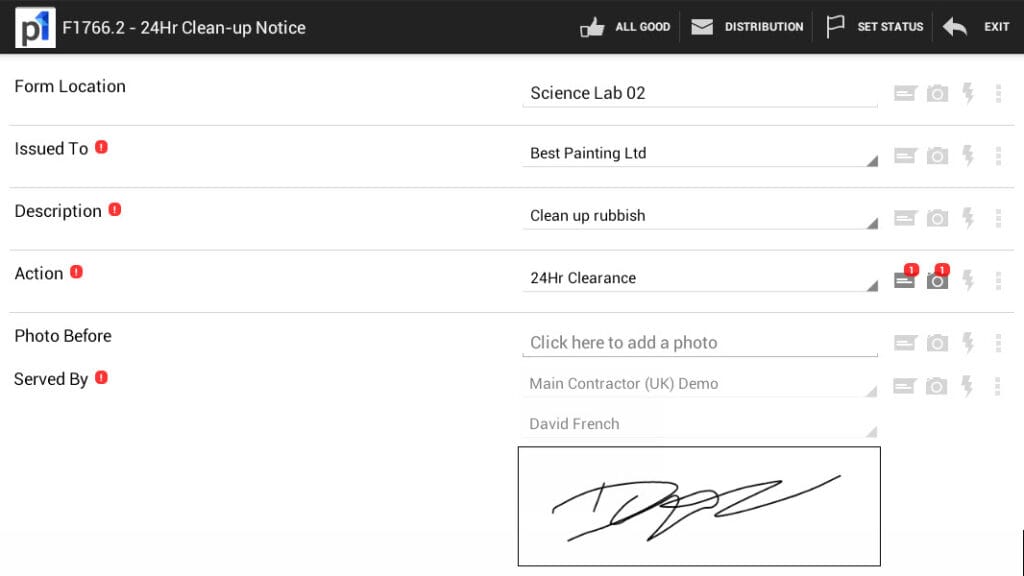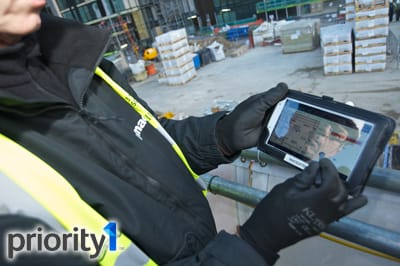Interview with Richard Scott from Priority1

UPDATE 2022: Priority1 is now Viewpoint Fieldview
The digitization of the construction industry is gaining more momentum with the use of tablets for site inspections and SaaS platforms, which aim to make everyone’s life on site easier and probably tidier.
I recently had the opportunity to discuss with Richard Scott , Managing Director of Mobile Computing Systems Ltd, about their solution Priority1 which is in the market since 2001.
So, what is Priority1? What’s the story behind it?
Back in 2001, the MD of a regional construction firm saw a story about a project we had delivered for a local food manufacturing company, called me and said, “I want to put mobile technology on my construction site.” We talked about problems with the snagging process and the result was a mobile system based on the PalmPilot device. It was such a success we decided to start knocking on the doors of other construction companies across the UK asking to demonstrate it.Priority1 today is tablet enabled and Cloud based. It is a task management, forms & process control system for use within a live construction project environment. Any paper based operation that involves pen, paper or camera can be quickly and easily re-engineered for use on a tablet computer or via the Web. Information on site is collected quickly and efficiently, then communicated to the people and organisations that need to work with it in a timely manner. Managers have greater visibility of operations and performance across their project, making measurable improvements in quality, safety and the working environment while helping to reduce costs and save time.

How many and what kind of Projects have used Priority1 up to now and how exactly did it help them?
We have been involved in over 600 projects within the last 12 years many of which are high profile landmark projects. BAA used Priority1 during the handover and completion of Terminal 5 and we worked on 3 of the major venues of the 2012 Olympics. High profile education projects include the Thomas Deacon Academy in Peterborough, as well as major new healthcare projects that include Queen Elizabeth Hospital Birmingham and Southmead Hospital in Bristol. Priority1 has also been used on many residential, commercial and infrastructure projects.
Project teams that use Priority1 spend far less time managing paperwork and communicating instructions with the project team and supply chain – we are all about dealing with the abundance of paper based forms that are completed by hand using a clipboard and pen whilst out on site. Paper forms which contain important information are handled many times and often re-typed into computers, printed then distributed to the people that need to work with it. Carillion Construction calculated that they have reduced the administration effort associated with managing snagging instructions alone by over 70%. For us it’s not just about reducing admin; we want to improve the speed, accuracy and availability of information throughout the entire project and to create integrity within the data that allows effective analysis and reporting at the business level.
How exactly Priority1 could help a Quality Manager or a Quality Engineer on site (and back in the office of course)?
Quality managers, engineers and site teams rely on information to make informed decisions that help drive improvement.
Priority1 provides a framework that improves the way that information is collected, managed, distributed and reported. The key point here is the word “framework”. Using Priority1 you can build or re-engineer the way you work – we provide tools and you decide how they are applied and what you build with them.
One of our biggest customers has re-engineered over 250 business forms and permits; including drainage and pile cap inspections, concrete pour checklists, quality inspections, work permits, audits and NCR’s – basically everything that ever saw the light of day on site.

There are many online collaboration tools, snagging apps and Document Management software for construction industry out in the market at the moment. What makes Priority1 different?
There are a number of things which set Priority1 apart from the competition. They are a result of our history and collaborative approach to product development with our customers; our reputation as a trusted partner with major construction firms has been earned over more than a decade. Priority1 has versatility and extensive functionality because of our approach to working with our customers and user community. Priority1 is the accumulation of years of feedback, requests and ideas contributed by the people who wear the hardhats and rigger boots working out on site in the live project environment. In November 2013 we hosted our 6th annual user conference. We listen carefully to what our customers say and we try our best to give them what they want. We generally have 3 major product releases per year, we have a client focus group and we have ways to encourage our customers to contribute to our development roadmap.
Everyone in construction industry is talking about BIM, the last 5 years. Is Priority1 collaborating with BIM Software and models? In what way?
We have been engaged in the conversation around BIM since its emergence. We asked a very direct question at our 2011 user conference when we asked our customers, “What would you like us to do about BIM?” Through meeting business teams involved with BIM and Digital Engineering over the last few years I have learned 3 things. BIM exists primarily within the design function, it is used for high level clash detection and other aspects at the design stage; BIM is also used as a marketing tool and currently has little day-to-day tactical relevance to the project team responsible for delivering the project at the point of construction. However, I have no doubt that BIM is here to stay and it will become more pervasive but I think that there is still a way to go before there is a seamless flow of information structured around BIM that extends between the design team and the construction team. In the meantime we are continuing to work with our construction partners, and we are trying to identify how we can contribute towards the solution. We do, however, see some more immediate opportunity to add value in relation to BIM via COBie and we are investigating this more proactively.

All snagging and completion of the forms are performed through the native Priority1 Android App. Are there any plans for iOS and iPads?
Completion of tasks and forms can be carried out using our Web interface as well as on the native Android app but we have no plans to support iOS in the immediate future and this often raises eyebrows. Priority1 has gone through 3 technology evolutions. We began in 2001 on PalmOS, then moved to Windows Mobile and more recently to Android Tablets. The decision to initially target Android was based on providing customer choice; we had hundreds of industrial grade PDA’s in operation and we were proud to offer devices that were fit-for-purpose. We have clients who have run Motorola MC65 device stock that was over 5 years old. At the time, we felt that we had an obligation to our customers to offer the choice of industrial grade tablets and only Android allowed this through manufacturers like Panasonic and Motorola. The reality was that our customers choose to use lower cost consumer grade tablets and we now have over 600 mobile devices using Priority1 each day. We have great working relationships with the IT functions within our customer base and over the last few years we have been in conversation about what their long term strategic direction was with respect to mobile technology, and we have been surprised. The vast majority of our customers have told us that we need to focus on delivering Priority1 onto Windows tablets. I thought that there would be more organisations that would ask us to target iOS and iPads but that just hasn’t been the case, so we plan to have support for Window tablets before the end of 2014.
If there are items (e.g. NCRs, RFIs) that need to be communicated to people that are not using Priority1 and they may not even belong to your organization (Clients, Designers, Authorities), is it possible to do so?
Yes. Last year we delivered a suite of functions within Priority1 to support the involvement of people and organisations who need to participate in the completion of a form based process when they aren’t part of your organisation. The functionality involves the concept of a form owner who has the capability to issue form contributor requests; these are issued as emails that contain a hyperlink to the form in question. The contributor works with a Web version of the form and can interact with it, viewing and updating the form according to the permissions which they have been given by the form owner. The owner has visibility of the whole contributor request process and is notified of form updates as they are made.

What kind of statistics, KPIs or dashboards can you produce with Priority1? Are they automatically produced or people still have to export to spreadsheets and registers?
We have several approaches to analysis and KPI’s. Each project user has the ability to build a bespoke project dashboard that represents the information they need to see. For example, a site manager may only be interested in the block they are managing and a particular set of sub-contractors. We have an OLAP Cube that provides the ability to use pivot table-like functionality allowing analysis of data across projects; this is very powerful and is often used to produce summary reports that are delivered to the business. More recently we have focused on full blown Business Intelligence. We have worked with a major Business Intelligence vendor and integrated their engine directly into Priority1. This allows custom business dashboards to be built and delivered throughout the business. For example, we recently worked with a client to automate the Health & Safety Group reporting. H&S inspections are performed using Priority1 tablets and the data is used tactically to keep the site safe and deal with issues quickly and effectively. The data from across all the projects is then accumulated and presented through a dashboard interface that allows some very powerful reports and charts to be run, with all the analytical functions, interaction and drilling facilities available that you might expect from a best in class BI solution.
It seems that the last 5 years the use of tablets on site is booming, with new apps and tools coming out almost every year. How soon do you think the construction industry will move completely into a “tablet-digital world”? Is that even possible?
Tablets are set to outsell PC’s and laptops; a new generation of engineers have been brought up in the Google world and expect information on-demand. The Internet is extending to devices like kitchen equipment and energy meters and wearables like Google Glass offer the ability to augment reality. My prediction is that within the next 10 years we will see mobile technology become ubiquitous and before long a young engineer will look at a suspended ceiling and ask for the ventilation ductwork 3D schematic to be augmented over what he sees, a new spin on the boyhood dream of x-ray specs.
What are the future plans for Priority1? Are there any new features coming out?
We have a number of features in the pipeline all driven by our user community. They include real-time synchronisation that makes more effective use of the 4G network; the development of an API that will allow Priority1 to integrate with other systems which will intend to BIM in the future; support for Windows tablets and the development of our cloud infrastructure to support global operations. These are some of the bigger pieces of our roadmap alongside a steady flow of features and functions that have been requested by our user community that just help to make them more effective day-to-day.
Many thanks!
UPDATE 2022: Priority1 is now Viewpoint Fieldview
Member discussion